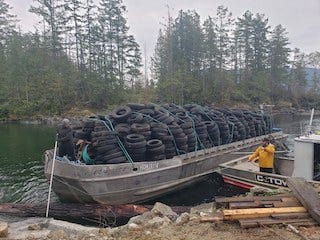British Columbia’s Local Fix for Tire Waste
When you think of Ocean Legacy Foundation (OLF), you might envision bands of volunteers combing beaches, lifting cigarette butts and empty water bottles with trash-grabbing poles.

When you think of Ocean Legacy Foundation (OLF), you might envision bands of volunteers combing beaches, lifting cigarette butts and empty water bottles with trash-grabbing poles. But the Foundation, known for its work cleaning up plastic litter from oceans and shorelines, goes after other waterway-bound trash too, including rubber from tires and polystyrene foam that’s packed inside those tires. While tire scraps, and especially foam, wreak havoc on aquatic ecosystems, the material has value to recyclers and the industries they sell to.
So, the Canadian-based nonprofit has targeted abandoned tires since its start in 2014. Since 2021, when it began tracking intake data, its crews have removed 4,000 tires from the marine environment, sending them on to processors who give them second lives in many forms. Now the Tire Stewardship British Columbia (TSBC), Canada’s oldest scrap tire recovery program, is providing the Foundation $150,000 over five years to support its cleanup expeditions along BC’s coastline, helping to see that the rubber scraps and foam are put to use.
TSBC, operating in one of Canada’s top tire-generating provinces, processes over 5.5 million car tire equivalents every year. The BC agency helps producers ensure the tires that they sell are well managed at the end of their lives and has no problem finding offtakers. Recovered material goes to Western Rubber who runs one of North America’s largest whole-tire-to crumb rubber facilities. Industry giant North West Rubber uses the recycled product from Western to manufacture mats and other products.

What’s sparking interest is the program’s success in balancing three priorities: achieving environmental, economic, and social outcomes, says Rosemary Sutton, executive director Tire Stewardship BC.
The monies TSBC provides OLF will take some weight off the ocean trash-fighting nonprofit’s shoulders, offsetting its outlay to have foam removed and recycled, says Chloé Dubois, co-founder and executive director Ocean Legacy Foundation.
OLF will use the new funding to purchase specialized machinery to separate foam from rubber, reducing the tedious manual work that historically has gone into this process. Some of the monies will cover labor and disposal costs associated with managing the high volumes of these bulky materials.
“The funding is particularly helpful as it does not come with the rigorous reporting that grants often do. TSBC has seen the work that we have done over the past nine years to manage tires and has put faith in our ability to allocate the funds responsibly. They recognize that granular reporting puts administrative burden on both entities,” Dubois says.
Besides lending financial backing, TSBC is helping its nonprofit partner expand its network, connecting the Foundation to stakeholders across BC who need help managing foam-filled tires littering marine environments, and introducing the Foundation to a nearby recycler that has processed over 100,000,000 tires by now and is looking for more of them.
There is plenty of stock out there. In 2022 OLF pulled over 2,400 tires from one small islet off of the Sunshine Coast alone. Not an easy job, as the 30-member team had to navigate this natural haven-turned-dumpsite’s rocky and sloping outcroppings, with no landing area, then load the tires onto a barge, enroute to Liberty Tire/Western Rubber in Delta. The formal partnership with TSBC has made a daunting job a little easier.
TSBC has engaged in multiple initiatives over the years to divert old tires from the province’s landfills and to grow a local rubber recycling market. Some of its contributions include incentivizing recycled rubber manufacturers to use BC-made crumb, and investing capital to advance home-grown innovations such as composite rubber products made from old car tires.
The agency has also awarded close to $6 million in community grants to school districts, municipalities, civic groups, churches, and others that use recycled tire products made in BC from BC recycled tires. Over 300 projects have moved forward with a lift from this grant program—from playgrounds to water parks to bike paths and walkways.
Ocean Legacy keeps on its march too.
“We continue to find foam-filled tires along the BC coast,” Dubois says.
“Through publicity gained in part from the partnership with TSBC, Ocean Legacy has become known as a recycling outlet for these tires by citizens, businesses in the marine and dock-building industries, as well as other shoreline cleanup groups who bring them directly to us.”
About the Author(s)
You May Also Like




